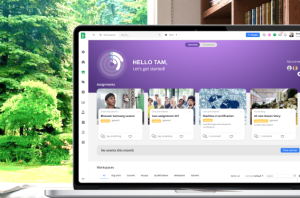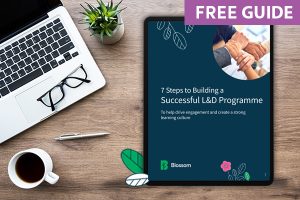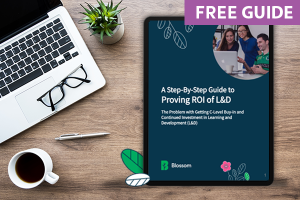This article takes you through the preliminary preparation stage for your LMS, advising you on how to choose an LMS, thus enabling you to make an informed decision.
Traditional Learning Management Systems (LMS) can be challenging to set up smoothly without access to proactive support from your LMS provider. Many LMS providers require ongoing and time-consuming maintenance and they’re not always customised to what your organisation requires. All of this can be prevented with the careful selection of your LMS provider. Selecting the right LMS results in streamlined training, an engaged team, simplified budget management, and more.
This article takes you through the preliminary preparation stage for your LMS, advising you on how to choose an LMS, thus enabling you to make an informed decision.
1. Define your business goals
An honest analysis of where your business is at today will truly help you to choose an LMS:
- What business challenges are you struggling with?
- What processes are currently taking too long?
- What skillsets are you missing from your in-house team?
- How engaged is your team?
- How long are you spending collecting actionable data from your organisation’s performance?
It’s also key to consider where you want your business to be in one year, two and five years. Ultimately, you want to be looking at Learning Management Systems that have the functionality that enables you to achieve your objectives now and in the future. There are learning management systems that specialise in e-learning while others specialise in team management. Keep your business goals at the forefront of your decision to ensure your LMS smashes your expectations.
2. Be prepared to use your chosen LMS in all your business processes
A unified way of working results in time-saving success. This involves an all-hands-on-deck approach across your team. Introducing the use of an LMS to a particular process involves careful planning so once the set-up is complete, your team can begin adopting this new way of working straight away. Collaborative training and communication ensure that your entire team participates cohesively.
Analyse all your business processes and consider which ones would benefit from the adoption of an LMS. This careful analysis helps you choose the right LMS because you can eliminate providers who aren’t capable of automating your team-specific processes.
3. Consider the integration of your data
Similar to the point above, an LMS depends on a unified way of working. Your LMS cannot work alone. It’s essential that your LMS is connected to every other information system throughout your organisation.
Here are some points to consider:
- What data do you want to have in your learning system?
- Where will this data come from? Is it already in digital form?
- What current information systems do you want to integrate into a Single Sign On (SSO) user authentication process?
- Who in your team will have the role of creating and maintaining system integrations and user interfaces to your LMS system?
- Where can historical data be obtained on the performance of employees in your organisation?
- How will you convert your existing data so it’s ready to use in your new LMS system?
4. System location: Will your LMS use an organisational server or be on the cloud?
The cloud has many benefits which is why more businesses today are migrating to cloud-based servers.
These benefits include:
- Complete accessibility of systems from mobile devices, allowing mobile learning.
- Data is backed up regularly.
- You only pay for what you use.
On the other hand, some organisations have concerns over information security and prefer to host all their own data and have control over what happens to it.
This is your decision. Now is the time to examine this, speaking to your IT team about their thoughts. Some LMS systems exclusively work in the cloud, you can eliminate these if your organisation only uses its own servers.
5. What’s your budget?
Before you start working with potential LMS suppliers, you should formulate a budget framework. The process of choosing an LMS is no trivial matter; it takes the investment of valuable time. Being equipped with a suitable budget ensures you understand your ROI, and you have realistic expectations for what an LMS can do for your business.
6. Ensure you have sufficient human resources to setup your LMS
Unfortunately, LMS systems can’t instantly set themselves up on their own. They require adaptations, customisations, and assimilations. Content needs to be created and uploaded. The process requires you to establish training and certification courses.
Next up is the testing phase with conducted pilots and ensuring the LMS perfectly integrates with other existing systems.
These actions take considerable time. As a rule of thumb, the assimilation process requires the average organisation to devote between 2 and 4 days for a skilled worker per week, for a period of between 3 and 6 months.
7. Gain commitment from your leadership team
This can be seen as one of the most influencing factors in the process because often management can be the bottleneck that slows down the selection process of an LMS. An enthusiastic commitment from management speeds up the process.
What does this commitment look like?
- Allocation of sufficient financial resources.
- Enabling the availability of employees who will be required for the testing and setting up of the LMS.
- Fully supporting the change of work procedures caused by the LMS.
- Supporting the cross-departmental collaboration that will ensure that your LMS is fully integrated into all your processes.
8. Specify what capabilities you need from your LMS
Once you’ve defined your business goals, you’ll have a pretty good idea of what you need from your LMS. Be specific and don’t hold back on the details. Speak to all relevant parties from your organisation to confirm their ideal LMS functionality. What features would help them in their job role? Once you have documented your ideal features, you can begin prioritising them.
To keep it simple, separate each one into these categories:
- Essential
- Important
- Nice to have
There’s no need for stylistic language.
For example, this request:
“The employee needs to pass his personnel card in the card reader near the classroom to record his attendance.”
It documents the required process and shows a clear need for the capabilities of the LMS.
9. Gear up for change
Without the right preparation, every system resists change. Introducing or replacing a Learning Management System changes the defined procedures in an organisation. Respect resistance but create a solution to it.
For example, using an LMS majorly reduces the need for paper, yet many organisations continue to print the reports their LMS has produced, continuing their wasteful old ways of working.
As humans, we dislike change and often champion the current ways we work. It’s in our nature. Information systems support a more efficient way of working with processes, transparency, and automation.
The aim is for your organisation to embrace and absorb your new LMS. This is quickly achieved by branding the system, creating a launch campaign, and a launch party to smooth the entry of the LMS system into your organisation.
10. Do you need to hire an LMS consultant?
The decision of whether to use consultants is complex: There are consultants with a clear agenda and there are some without.
The key decisions to make are choosing the right consultant and knowing when the right time is in the deployment process to hire one. Ask other companies who have worked with particular consultants to gauge their experience with them, especially if the projects you both needed a consultant for are similar. Drill down into whether the consultant has a self-serving agenda, like gaining sales commissions. Are they recommending the same LMS provider, regardless of the needs of the organisation?
Consultants have many benefits. One key benefit is that a good consultant can draw up an orderly work plan, shorten your time frames, and help you to remain focused.
Final thoughts
Choosing the right LMS system to meet the needs of your organisation is no easy process. These 10 suggestions help you choose the right LMS and also prepare your organisation for the implementation of a new system.
Find out more about how to choose the best LMS for you organisation by reading the next article of this guide: 12 Tips on Choosing a Learning Management System Provider – Choosing an LMS Part 2








